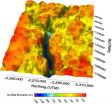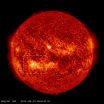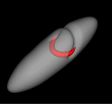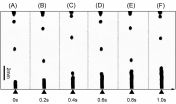(Press-News.org) Thanks in part to support from NASA and the National Science Foundation, scientists have produced the first-ever detailed maps of bedrock beneath glaciers in Greenland and Antarctica. This new data will help researchers better project future changes to glaciers and ice sheets, and ultimately, sea level.
Researchers at the Center for Remote Sensing of Ice Sheets, or CReSIS, at the University of Kansas in Lawrence, Kansas, recently built detailed maps of the terrain beneath Greenland's Jakobshavn Glacier and Byrd Glacier in Antarctica. The results of this study were published in the September issue of the Journal of Glaciology. CReSIS is a major participant in NASA's Operation IceBridge, a NASA airborne science mission aimed at studying Arctic and Antarctica land and sea ice.
CReSIS researchers used computer software to process and analyze data collected during field campaigns unrelated to IceBridge that were conducted in cooperation with NASA and NSF in 2008 and 2011 to build maps of the two glaciers. These data were from an ice-penetrating radar instrument known as the Multichannel Coherent Depth Sounder / Imager, or MCoRDS / I, which is similar to the instrument IceBridge has used since 2009. Bed topography data are vital for computer models used to project future changes to ice sheets and their contribution to sea level rise. "Without bed topography you cannot build a decent ice sheet model," said CReSIS director Prasad Gogineni.
Jakobshavn Glacier is of interest because it is the fastest-moving glacier in the world and drains about 7.5 percent of the Greenland Ice Sheet. Having a map of Jakobshavn's bed has been a long-time goal of glaciologists. Byrd Glacier is also moving faster than average, but unlike many other glaciers, has been sounded in the past. Researchers mapped a previously unknown trench beneath Byrd Glacier and found that depth measurements from the 1970s were off by as much as a half mile in some places.
Ice-penetrating radar is one method for mapping bedrock topography. The instrument sends down radar waves, which reflect off of the ice surface, layers inside the ice sheet and bedrock back to the instrument, giving researchers a three-dimensional view. Ice-penetrating radar data from IceBridge flights helped build maps of Greenland and Antarctica's bedrock and were even used to discover a large canyon beneath the ice in northern Greenland.
Imaging rock beneath glaciers like Jakobshavn is important, but more difficult than mapping the ice sheet interior. The relatively warm ice and rough surfaces of outlet glaciers weaken and scatter radar signals, making the bed difficult to detect. To overcome these challenges, CReSIS used a sensitive radar instrument with a large antenna array and used several processing techniques to remove interference and build a view of sub-ice bedrock. "We showed that we have the technology to map beds," said Gogineni.
The MCoRDS / I instrument can be traced back to an early ice-penetrating radar CReSIS designed and built in the mid-90s in cooperation with NASA and NSF. In the two decades since then CReSIS has refined this instrument and has flown on NASA aircraft and alongside NASA instruments.
Researchers continue to improve instrument hardware and data processing and are looking ahead to mapping more glaciers in the future, which will likely involve small, unmanned aerial vehicles. "Improving ice sheet models means we need even finer resolution," Gogineni said. "To do this we need lines flown much closer together, which small UAVs would be well suited for."
INFORMATION:
For more information on NASA's Operation Ice Bridge, visit:
http://www.nasa.gov/icebridge
For more information about the Center for Remote Sensing of Ice Sheets, visit:
https://www.cresis.ku.edu/
NASA support key to glacier mapping efforts
2014-09-30
ELSE PRESS RELEASES FROM THIS DATE:
NASA-funded rocket has 6 minutes to study solar heating
2014-09-30
On Sept. 30, 2014, a sounding rocket will fly up into the sky – past Earth's atmosphere that obscures certain wavelengths of light from the sun -- for a 15-minute journey to study what heats up the sun's atmosphere. This is the fourth flight for the Very high Angular Resolution Ultraviolet Telescope, or VAULT, will launch from the White Sands Missile Range near Las Cruces, New Mexico.
The instrument, now called VAULT2.0, has been refurbished with new electronics and an imaging detector to capture images more frequently than before. While in space, VAULT2.0 will observe ...
Deceptive-looking vortex line in superfluid led to twice-mistaken identity
2014-09-30
So long, solitons: University of Chicago physicists have shown that a group of scientists were incorrect when they concluded that a mysterious effect found in superfluids indicated the presence of solitons—exotic, solitary waves. Instead, they explain, the result was due to more pedestrian, whirlpool-like structures in the fluid. They published their explanation in the Sept. 19 issue of Physical Review Letters.
The debate began in July 2013, when a group of scientists from the Massachusetts Institute of Technology published results in Nature showing a long-lived structure ...
New discovery approach accelerates identification of potential cancer treatments
2014-09-30
ANN ARBOR—Researchers at the University of Michigan have described a new approach to discovering potential cancer treatments that requires a fraction of the time needed for more traditional methods.
They used the platform to identify a novel antibody that is undergoing further investigation as a potential treatment for breast, ovarian and other cancers.
In research published online in the Proceedings of the National Academy of Sciences, researchers in the lab of Stephen Weiss at the U-M Life Sciences Institute detail an approach that replicates the native environment ...
Gene doubling shapes the world: Instant speciation, biodiversity, and the root of our existence
2014-09-30
What do seedless watermelon, salmon, and strawberries all have in common? Unlike most eukaryotic multicellular organisms that have two sets of chromosomes and are diploid, these organisms are all polyploid, meaning they have three or more sets of chromosomes—seedless watermelon and salmon have 3 and 4 sets of chromosomes, respectively, and strawberries have 10! While this might seem surprising, in fact most plant species are polyploid. Polyploidy, or genome doubling, was first discovered over a century ago, but only recently, with the development of molecular tools, has ...
Smithsonian scientists discover coral's best defender against an army of sea stars
2014-09-30
Coral reefs face a suite of perilous threats in today's ocean. From overfishing and pollution to coastal development and climate change, fragile coral ecosystems are disappearing at unprecedented rates around the world. Despite this trend, some species of corals surrounding the island of Moorea in French Polynesia have a natural protector in their tropical environment: coral guard-crabs. New research from the National Museum of Natural History's Smithsonian Marine Station scientist Seabird McKeon and the museum's predoctoral fellow Jenna Moore of the Florida Museum of Natural ...
Asthma symptoms kicking up? Check your exposure to air pollution
2014-09-30
ARLINGTON HEIGHTS, Ill. (September 30, 2014) – People who suffer from asthma may think there's not a lot they can do to control their asthma besides properly taking medications and avoiding allergic triggers.
According to a new article in the Annals of Allergy, Asthma and Immunology, the scientific publication of the American College of Allergy, Asthma and Immunology (ACAAI), asthma sufferers can learn lessons about managing their asthma by examining their lifestyle. The woman described in the Annals article improved her asthma once she and her doctor determined her ...
High-dose vitamin D for ICU patients who are vitamin D deficient does not improve outcomes
2014-09-30
Administration of high-dose vitamin D3 compared with placebo did not reduce hospital length of stay, intensive care unit (ICU) length of stay, hospital mortality, or the risk of death at 6 months among patients with vitamin D deficiency who were critically ill, according to a study published in JAMA. The study is being posted early online to coincide with its presentation at the European Society of Intensive Care Medicine annual congress.
A high prevalence of low vitamin D levels has been confirmed in patients who are critically ill. Many studies suggest that a low vitamin ...
Gut bacteria promote obesity in mice
2014-09-30
A species of gut bacteria called Clostridium ramosum, coupled with a high-fat diet, may cause animals to gain weight. The work is published this week in mBio®, the online open-access journal of the American Society for Microbiology.
A research team from the German Institute of Human Nutrition Potsdam-Rehbruecke in Nuthetal observed that mice harboring human gut bacteria including C. ramosum gained weight when fed a high-fat diet. Mice that did not have C. ramosum were less obese even when consuming a high-fat diet, and mice that had C. ramosum but consumed a low-fat ...
Endoscopists recommend frequent colonoscopies, leading to its overuse
2014-09-30
Boston, MA – A retrospective study led by researchers at Brigham and Women's Hospital (BWH), has found an overuse of colonoscopies for colorectal cancer screening and surveillance. The study demonstrated that endoscopists commonly recommended shorter follow-up intervals than established guidelines support, and these recommendations were strongly correlated with subsequent colonoscopy overuse.
"Our study shows that a high percentage of follow-up colonoscopies are being performed too early, resulting in use of scarce health care resources with potentially limited clinical ...
Chinese scientists unveil liquid phase 3-D printing method using low melting metal alloy ink
2014-09-30
Three-dimensional metal printing technology is an expanding field that has enormous potential applications in areas ranging from supporting structures, functional electronics to medical devices. Conventional 3D metal printing is generally restricted to metals with a high melting point, and the process is rather time consuming.
Now scientists at the Beijing Key Laboratory of CryoBiomedical Engineering, part of the Technical Institute of Physics and Chemistry at the Chinese Academy of Sciences, have developed a new conceptual 3D printing method with "ink" consisting of ...



